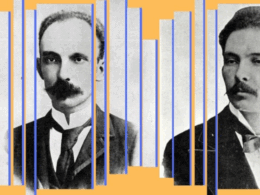We recently interviewed Jonathan R. Eller about the two-volume Library of America Ray Bradbury edition and the subject of illustrations and cover art came up—specifically, the artwork of Joseph Mugnaini, whose twelve illustrations for The October Country appear in the second volume. With the cooperation of the Mugnaini Estate and the help of Ryan Leasher, those illustrations have been remastered to a quality and crispness not seen since the original printings.
Born Giuseppe Mugnaini in Viareggio, Italy, on July 12, 1912, to Antonio and Concetta Mugnaini, he and his family immigrated to the United States when Mugnaini was three months old, and he was raised in Los Angeles. Enrolling in the Otis Art Institute in 1940, he left it in 1942 to join the United States military and served with the U.S. Army Intelligence Corps in Europe. Following the end of World War II, he joined the faculty at Otis, where he was teaching when he met Bradbury.
Eller explains how the collaboration between Bradbury and Mugnaini came about:
Joseph Mugnaini was aware of Bradbury’s The Martian Chronicles; some of his art students told him about Bradbury when he was teaching at his alma mater, Otis Art Institute, in the early 1950s, but Mugnaini usually limited his reading to the books he was illustrating. As it turned out, it would be Mugnaini’s art that would bring the two men together. Mugnaini was a multi-talented fine arts illustrator who could work in oil, watercolor, pen-and-ink, and was an accomplished lithographer as well. In April 1952 Bradbury encountered Mugnaini’s work at an art gallery showing and made contact.
In less than a year, Mugnaini was at work on illustrations for two of Bradbury’s forthcoming books. The twenty-two stories published in The Golden Apples of the Sun each opened with title art by Mugnaini, and Bradbury also engaged his new friend to provide cover illustrations and title art for Fahrenheit 451. The burning man at the center of the Fahrenheit 451 dust jacket, wearing armor formed of newspaper pages, became an enduring representation of Bradbury’s famous cautionary tale.

In the United States and in Great Britain, Mugnaini would provide well-known jacket art for The Golden Apples of the Sun, The October Country, and title art for many of the October Country stories. Early on during the process of creating the art for these books, Mugnaini demonstrated a clear understanding of the essence of the story behind each of his illustrations. Bradbury sensed that Mugnaini was able to create a mood in each illustration that also worked to convey a sense of the story behind it, and a brief discussion of a story was all that was needed; Mugnaini would then tell the story through his art—theme and all. Every element of a Mugnaini composition, no matter how small, had a purpose, and Bradbury came to appreciate the parallels to literary composition in Mugnaini’s process.
For nearly four decades, Mugnaini would collaborate on a number of special editions of Bradbury’s classic works and provide further jacket art for A Medicine for Melancholy (1959), Twice 22 (1966), and other Bradbury books. Bradbury’s sense of space-age wonderment and magical realism is perhaps best known through the jackets that Mugnaini painted for the young reader Doubleday collections of the 1960s, R Is for Rocket (1962) and S Is for Space (1966).
“I think Joe works very much the same way I do,” Bradbury said in an interview. “He floats over a thing. He takes inspiration from a story of mine and tries to forget a lot I’ve said. Otherwise, it would be no fun. If he was just repeating what I’d already said, his illustrations would be no fun. It’s the fact that Joe then gives me a gift of myself and him at the same time. And I say, ‘Hey, is that what I meant?’ Then I look at his illustration and I’ll be goddamned that it is. But it’s Joe, too. So that’s why we’ve had a real twin relationship so many years, so happily.”





